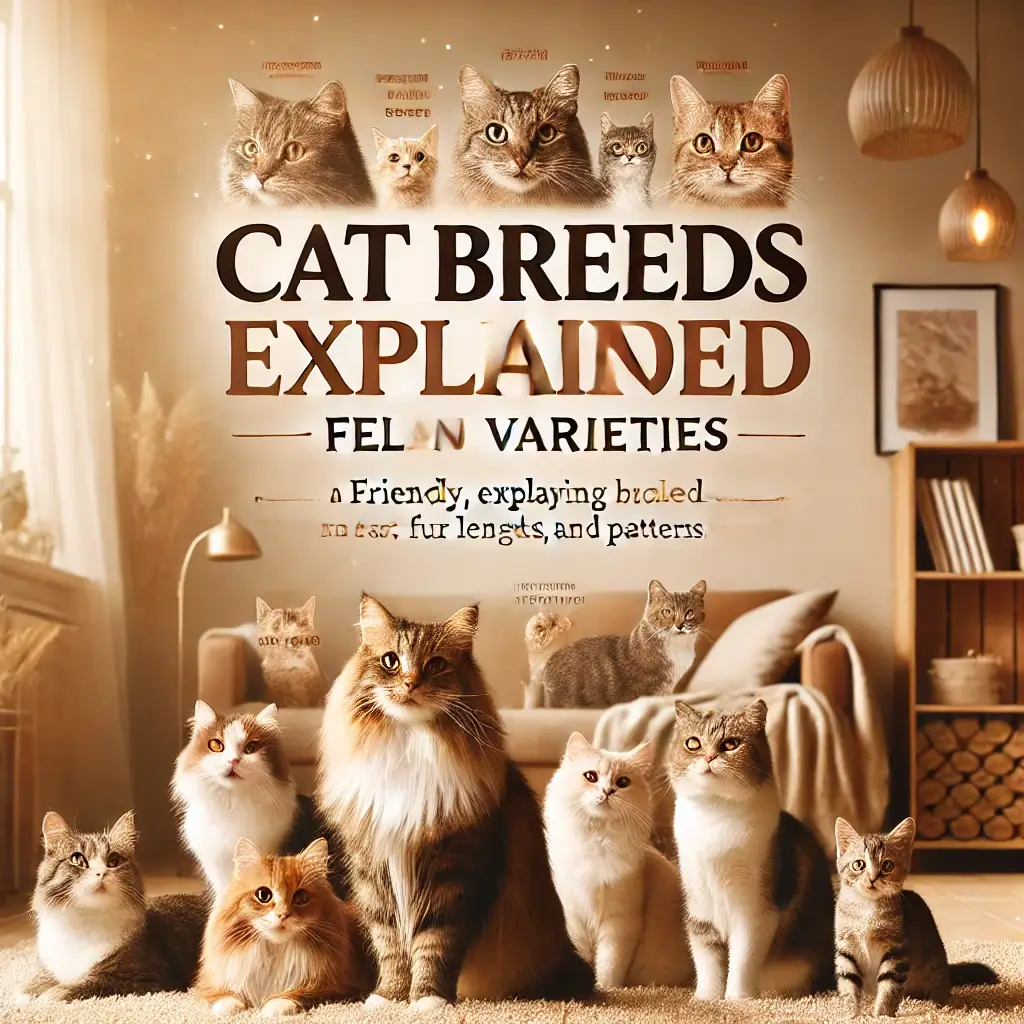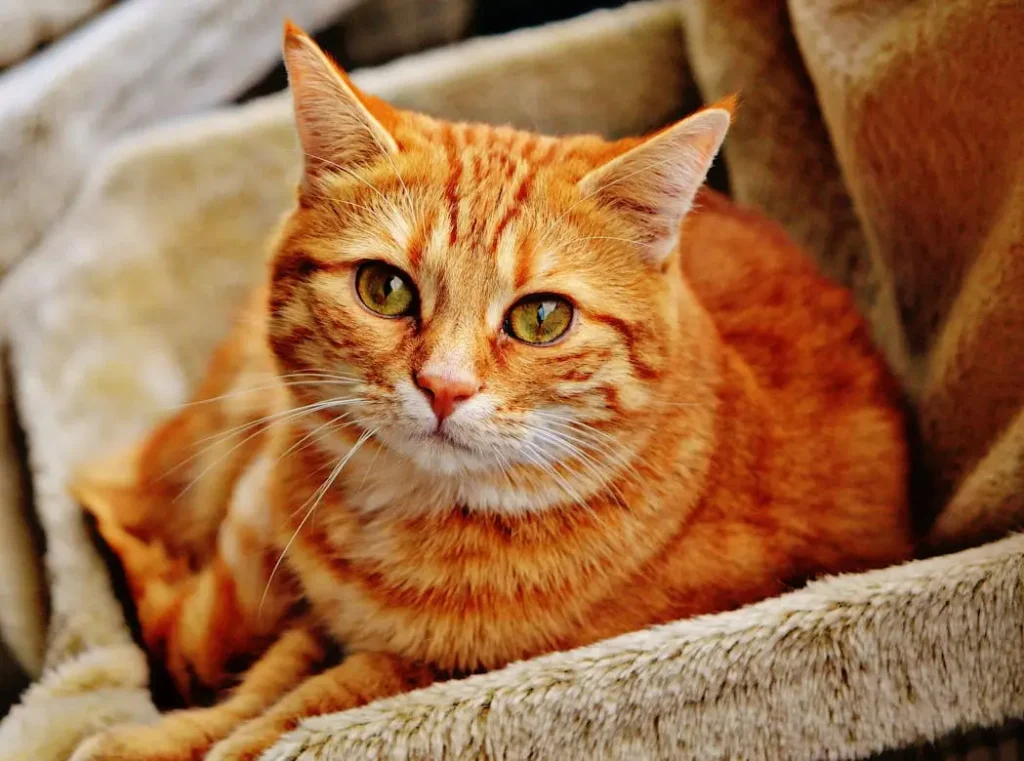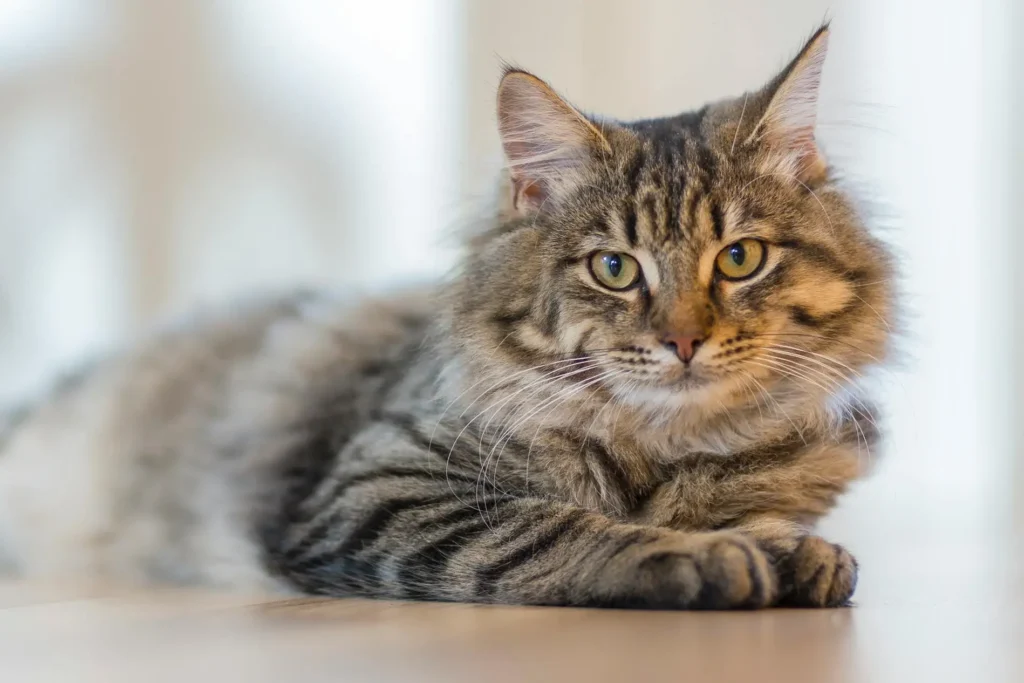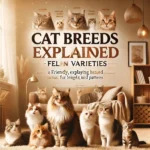Now Reading: Cat Breeds Explained: Feline Varieties
-
01
Cat Breeds Explained: Feline Varieties
Cat Breeds Explained: Feline Varieties

🐾 Introduction: The Fascinating World of Cat Breeds
Cats have captivated human hearts for centuries with their mysterious nature, playful antics, and unique personalities. Across the globe, there are dozens of recognized cat breeds, each with distinct characteristics that set them apart. From the silky-coated Persian to the vocal Siamese and the majestic Maine Coon, the world of feline breeds is as diverse as it is fascinating.
🐈⬛ Diversity and Uniqueness
Cats come in various breeds, with differences in coat color, texture, body shape, and personality. These traits aren’t random; they result from genetic inheritance passed down through generations. Gregor Mendel’s research demonstrated that the genes inherited from parent cats determine whether a kitten has a tabby coat, blue eyes, or a long, flowing mane.
In fact, cat breeding has been influenced by genetics for centuries. Sometimes, surprises occur—a pair of tabby cats might give birth to a black kitten, or black parents might unexpectedly produce blue kittens. This mystery of inheritance has intrigued both scientists and cat enthusiasts alike, leading to fascinating discoveries about the mechanics of feline genetics.
🌏 Global Origins: A Rich Heritage of Breeds
Cats have traveled the world, evolving alongside human civilizations. From the sacred Egyptian Maus, cherished as divine protectors in ancient temples, to the Siberian cat, bred to survive Russia’s harsh winters, each breed tells a story of adaptation, culture, and human ingenuity.
🐾 Understanding Cat Breeds: What Makes Them Unique
Cat breeds are more than just fluffy coats and cute faces—they’re a product of genetics, behavior patterns, and historical influences. Each breed’s distinct appearance and temperament come from a complex interplay of hereditary factors passed down through generations. From the chatty Siamese to the laid-back Ragdoll, understanding what makes each breed unique requires a closer look at genetics, behavior, and historical development.
🧬 Genetic Differences: The Blueprint of Feline Diversity
Every cat is a walking genetic mosaic shaped by genes inherited from both parents. Gregor Mendel’s research showed that hereditary traits—like fur length, coat color, and body shape—are passed down in predictable patterns.
For instance:
- Coat Length: A long-haired Persian owes its luxurious mane to a recessive gene. When two short-haired cats carry this hidden gene, they can surprise their owners with long-haired kittens.
- Color Patterns: Thanks to the dominance of the black color gene, a black cat may have parents with tabby coats. Genetics can also produce unexpected results—like a blue kitten from two black cats—due to recessive genes resurfacing after generations.
🔍 Did You Know?
The domestic cat (Felis catus) has 38 chromosomes organized into 19 pairs. Each parent passes down half of these chromosomes, so a kitten might inherit its mother’s coat color and its father’s eye shape.
🐾 Behavioral Variations: Why Personality Differs by Breed
Behavioral traits are as heritable as physical ones. Breed genetics influence a cat’s activity level, vocalization, and social tendencies.
For example:
- 🗣️ Siamese cats are famously vocal due to genetic predispositions that make them more sociable and talkative.
- 🛋️ British Shorthairs tend to be calm and independent, reflecting generations of selective breeding for companionship without clinginess.
- 🌪️ Bengals often display wild, energetic behaviors inherited from their leopard cat ancestors.
🔍 Fun Fact:
The Maine Coon, known for its gentle demeanor, was once a working cat on New England farms. Generations of natural selection favored friendly, adaptable cats that were skilled hunters.
📜 Breed Origins: The Historical Journey of Cat Breeds
Many breeds carry cultural and historical significance. Cats have traveled across continents—often with sailors and merchants—and have been deliberately bred for specific characteristics.
- 🏺 Egyptian Mau: Believed to be the descendant of cats revered in ancient Egypt, where they were symbols of protection.
- 🇷🇺 Siberian Cat: Originated in cold Russian forests, developing a dense, water-resistant coat to survive freezing winters.
- 🇬🇧 British Shorthair: Brought to Britain by Roman soldiers and later refined into a robust, easygoing breed.
🔍 Did You Know?
The Turkish Van has an unusual fondness for water—a trait linked to its origins in the Lake Van region of Turkey, where swimming helped with survival.
🎯 Key Takeaway:
Cat breeds differ not just in appearance but in personality and historical significance. Understanding these genetic, behavioral, and historical distinctions helps potential owners choose the right breed for their lifestyle.

🐾 Popular Cat Breeds: A Quick Overview
With dozens of recognized cat breeds worldwide, each with distinct physical and behavioral traits, choosing the right one can feel overwhelming. Some cats are playful explorers, while others prefer calm naps by the window. This section will briefly overview popular cat breeds, categorized by their coat type, origin, and temperament. Follow the links provided to dive deeper into each breed’s unique characteristics.
🟢 Short-Haired Breeds: Low Maintenance & Active
Short-haired cats are easy to groom, energetic, and adaptable—making them perfect companions for busy households. Their sleek coats require minimal brushing, yet their playful nature keeps their humans constantly entertained.
- 🐾 British Shorthair (The Placid Guardian):
Known for its plush, dense coat and easygoing personality, the British Shorthair is a beloved companion in many homes. These cats are affectionate but independent, often described as gentle teddy bears. (Read more: British Shorthair Cat Profile) - 🐾 Abyssinian (The Curious Explorer):
Abyssinians are dynamic and adventurous. With their sleek, ticked coat and inquisitive nature, these cats love to climb and explore. They’re perfect for owners who enjoy interactive play. (Read more: Abyssinian Cat Profile) - 🐾 American Shorthair (The Hardy Companion):
Originally known for their mouser abilities, American Shorthairs are strong, adaptable, and easygoing. Their short, dense coat requires little grooming, and they’re sociable without being clingy. (Read more: American Shorthair Cat Profile)
🟣 Long-Haired Breeds: Luxurious & Elegant
Long-haired cats bring a touch of elegance to any home. Their silky, flowing coats need regular grooming, but their regal appearance makes it worthwhile.
- 🐾 Persian (The Gentle Aristocrat):
The Persian cat epitomizes feline elegance with its long, silky fur and flat-faced charm. These cats are calm and affectionate, preferring quiet, cozy spaces over rowdy environments. (Read more: Persian Cat Profile) - 🐾 Maine Coon (The Gentle Giant):
Known as the largest domestic cat breed, Maine Coons boast thick, shaggy coats and lion-like ruffs. They’re friendly and sociable, often described as dog-like due to their loyal personalities. (Read more: Maine Coon Cat Profile) - 🐾 Birman (The Sacred Companion):
Legend has it that Birmans were the sacred temple cats of Burma. Their silky coat, white gloves, and striking blue eyes give them a mystical appearance, while their gentle temperament makes them perfect family pets. (Read more: Birman Cat Profile)
🟡 Exotic & Rare Breeds: Unique Traits & Origins
These breeds stand out due to their unusual appearance, origin, or behavior. Whether it’s a hairless Sphynx or a wild-looking Savannah, these cats add an element of surprise to the feline world.
- 🐾 Sphynx (The Playful Extrovert):
The Sphynx cat is instantly recognizable with its hairless body, wrinkled skin, and bat-like ears. Despite its alien-like appearance, the Sphynx is affectionate, energetic, and loves human attention. (Read more: Sphynx Cat Profile) - 🐾 Savannah (The Wild Elegance):
A cross between a domestic cat and an African serval, the Savannah boasts striking spotted coats and tall ears. These cats are active, curious, and highly intelligent. (Read more: Savannah Cat Profile) - 🐾 Scottish Fold (The Owl-Like Companion):
Known for its adorable folded ears that give it an owl-like appearance, the Scottish Fold is a playful, people-oriented breed. (Read more: Scottish Fold Cat Profile)
🔴 Hybrid Breeds: Crossbreeds with Distinct Traits
Hybrid cats are bred by crossing domestic breeds with wildcats or mixing distinct breeds to create unique coat patterns and personalities.
- 🐾 Bengal (The Mini Leopard):
With its sleek, muscular build and wild-looking coat, the Bengal resembles a mini leopard. They are energetic, curious, and love water—a rare trait in domestic cats. (Read more: Bengal Cat Profile) - 🐾 Ocicat (The Wild-Looking Companion):
Despite its wild appearance, the Ocicat is a 100% domestic cat. Its spotted coat mimics that of wild ocelots, but it’s a loyal and affectionate companion. (Read more: Ocicat Cat Profile) - 🐾 Toyger (The Mini Tiger):
As its name suggests, the Toyger has bold stripes that resemble a tiny tiger. This breed was developed to inspire conservation awareness for wild tigers. (Read more: Toyger Cat Profile)
🎯 Key Takeaway:
From short-haired companions to long-haired beauties and wild-looking hybrids, the world of cat breeds offers something for every cat lover. To explore more about each breed, click the links above and discover what makes each feline variety special.
🐾 Factors That Distinguish Cat Breeds
While cats share many common traits—like their graceful movements and instinctive hunting skills—each breed also has distinct characteristics that make it unique. These differences stem from genetics, environmental factors, and centuries of selective breeding. Understanding the key factors that distinguish cat breeds can help you choose a cat that fits your lifestyle. Let’s explore the three primary factors that set breeds apart:
Coat Color & Pattern: A Visual Signature
A cat’s coat color and pattern are often the first noticeable features. Coat patterns are determined by genes inherited from both parents. Gregor Mendel’s genetic principles revealed that certain coat traits—like solid vs. tabby or long-haired vs. short-haired—are predictable when understanding dominant and recessive genes.
Common Cat Coat Patterns:
- 🐾 Solid/Uniform: One consistent color throughout the coat (e.g., Russian Blue).
- 🐾 Tabby: Stripes, swirls, or spots—the most common pattern found in domestic cats. (e.g., Abyssinian or American Shorthair).
- 🐾 Color-Point: Lighter body with darker extremities (ears, face, paws, tail) due to temperature-sensitive genes. (e.g., Siamese and Birman).
- 🐾 Bicolor: A coat with two distinct colors, often white, paired with another color. (e.g., Turkish Van or British Shorthair).
- 🐾 Tortoiseshell/Calico: Mixed patches of black, orange, and cream, often with unique patterns. (More common in female cats due to X-chromosome-linked genes).
🔍 Did You Know?
A black cat can unexpectedly produce blue kittens if it carries a recessive gene for diluted coat color. In such cases, the blue trait may reappear after several generations—a fascinating example of hidden genetic inheritance.
🐕 Body Structure: Shapes, Sizes, and Features
Cat breeds vary significantly in body structure—from slender, athletic builds to large, muscular frames. These differences often reflect their evolutionary background and genetic makeup.
Key Body Structure Categories:
- 🐾 Cobby Body (Compact & Muscular): Short legs, broad chest, and dense build. (e.g., Persian or Exotic Shorthair).
- 🐾 Foreign Body (Slender & Elegant): Long legs, narrow chest, and streamlined physique. (e.g., Siamese or Oriental Shorthair).
- 🐾 Semi-Cobby Body (Balanced Structure): A blend of cobby and foreign—medium build with well-proportioned features. (e.g., British Shorthair or Scottish Fold).
- 🐾 Large & Muscular (Gentle Giants): Strong bones, broad chests, and substantial muscle mass. (e.g., Maine Coon or Siberian).
🔍 Fun Fact:
The Maine Coon—one of the largest domestic cats—can weigh up to 20 pounds and has tufted ears to help it hear prey more efficiently in snowy environments.
🧠 Personality & Temperament: Nature vs. Nurture
A cat’s personality and behavior are influenced by both genetics and environment. While individual personality varies, certain traits are breed-specific due to selective generational breeding.
Behavioral Traits Across Breeds:
- 🐾 Vocal & Social: Siamese cats are known for their loud, persistent meows—a genetic tendency to stay highly communicative with their humans.
- 🐾 Laid-Back & Calm: British Shorthairs are typically reserved, patient, and independent, making them ideal for quieter households.
- 🐾 Playful & Energetic: Bengals are high-energy cats with strong hunting instincts, often engaging in climbing and water play.
- 🐾 Gentle Giants: Maine Coons display a dog-like friendliness and curiosity, with an affectionate nature despite their large size.
🔍 Did You Know?
The Scottish Fold’s folded ears are caused by a dominant gene mutation affecting cartilage development. This same genetic trait contributes to their playful, affectionate temperament.
🎯 Key Takeaway:
Cat breeds differ not only in appearance but also in behavior, genetics, and structure. By understanding these core factors, you’ll be better equipped to choose the right breed and nurture a strong, lifelong bond with your feline friend.
🐾 How to Choose the Right Cat Breed
Choosing the perfect cat breed isn’t just about picking the cutest kitten—it’s about finding a feline companion that matches your lifestyle, household dynamics, and personal preferences. Each breed has unique needs related to grooming, activity levels, and behavioral tendencies. Here’s a simple guide to help you select the ideal breed based on three critical factors:
👨👩👧👦 Family Considerations: Best Breeds for Families with Children
Cats can make wonderful family pets, but some breeds adapt better to busy households than others. Children’s energy levels and handling habits may overwhelm certain cats, while others thrive in family-friendly environments.
Top Family-Friendly Breeds:
- 🐾 Ragdoll (The Gentle Giant): Known for its docile and laid-back nature, it is patient and affectionate, often allowing children to carry it around like a soft toy.
- 🐾 Maine Coon (The Playful Companion): These large, sociable cats are highly tolerant of children and often participate in games and activities.
- 🐾 British Shorthair (The Independent Guardian): While they enjoy affectionate interactions, they prefer calm handling and are less prone to stress.
Breeds to Avoid in Loud Homes:
- Siamese Cats (sensitive to noise, may become anxious)
- Persians (prefer quiet, stable environments)
🔍 Pro Tip:
Teach children to interact gently with cats, respecting their boundaries and body language.
🏙️ Living Environment: Matching Breed to Space
Your living space plays a significant role in determining the ideal cat breed. While some cats love sprawling houses, others adapt well to apartments.
Apartment-Friendly Breeds:
- 🐾 Siamese (Playful & Vocal): Loves interactive play indoors and forms strong bonds with owners.
- 🐾 Scottish Fold (Calm & Adaptable): Adjusts easily to smaller living spaces as long as it has toys and scratching posts.
- 🐾 Russian Blue (Quiet & Reserved): Perfect for apartments due to its calm, low-energy nature.
Breeds Best for Spacious Homes:
- 🐾 Maine Coon (Needs room to roam)
- 🐾 Bengal (Requires vertical spaces and mental stimulation)
🔍 Did You Know?
Bengals need climbing structures—without one, they may scale bookshelves and curtains to satisfy their instinctive desire to climb.
🕐 Time Commitment: Grooming and Activity Needs
Different breeds require different levels of care, especially regarding grooming and stimulation.
Low-Maintenance Breeds: (Minimal Grooming, Independent Personality)
- 🐾 British Shorthair (Weekly brushing to remove loose fur)
- 🐾 American Shorthair (Short, low-maintenance coat)
- 🐾 Russian Blue (Minimal grooming; naturally clean cats)
High-Maintenance Breeds: (Daily Brushing, Regular Care)
- 🐾 Persian (Thick, silky fur that mats easily)
- 🐾 Maine Coon (Long, shaggy coat needs regular detangling)
- 🐾 Turkish Angora (Requires routine brushing and ear checks)
🔍 Time-Saving Tip:
Invest in de-shedding tools for long-haired cats and interactive toys for high-energy breeds.
🎯 Key Takeaway:
Choosing a cat breed requires more than just an emotional decision—it’s about finding a cat that fits your family dynamic, living space, and care preferences. The right breed will thrive in your home and provide years of companionship.

🐾 Cat Breeds and Health Considerations
While cats are generally resilient animals, different breeds come with unique health considerations. Genetics, lifestyle, and diet all influence a cat’s long-term well-being. Understanding these health factors is essential to prevent problems early and provide optimal care. Let’s explore some key considerations that every cat owner should know.
💉 Genetic Predispositions: Health Risks in Purebred Cats
Selective breeding has given us stunning breeds like the Maine Coon, Siamese, and Persian, each with distinct physical traits. However, this practice has also increased the prevalence of genetic health issues in some breeds.
Common Breed-Specific Health Concerns:
- 🐾 Maine Coon: Prone to Hypertrophic Cardiomyopathy (HCM)—a condition that thickens heart muscles and affects circulation.
- 🐾 Persians Often experience Brachycephalic Airway Syndrome due to their flat-faced (brachycephalic) skull structure, which can cause breathing difficulties.
- 🐾 Siamese & Burmese: At risk for Progressive Retinal Atrophy (PRA), leading to vision loss over time.
- 🐾 Ragdoll: Higher susceptibility to bladder stones and heart disease.
- 🐾 Scottish Fold: Due to the gene-causing folded ears, they often develop cartilage abnormalities and joint issues.
🔍 Genetics Tip:
When adopting a purebred cat, request health records from breeders and ask if genetic testing has been conducted for common hereditary conditions.
🩺 Preventive Care Tips: Proactive Health Management
Cats are masters at hiding illness, making preventive care crucial. Regular veterinary visits help catch potential issues early and prolong your cat’s life.
Essential Preventive Care Practices:
- 🐾 Annual Check-Ups: Schedule yearly vet visits to monitor weight, dental health, and organ function.
- 🐾 Vaccinations: Keep vaccinations current to protect against feline distemper, calicivirus, and rabies.
- 🐾 Parasite Control: Use preventive treatments for fleas, ticks, and intestinal parasites.
- 🐾 Dental Care: Dental disease is common in older cats—regular brushing and dental cleanings are essential.
- 🐾 Mental & Physical Stimulation: Provide interactive toys and climbing structures to prevent obesity and boredom-related issues.
🔍 Did You Know?
Indoor cats are less likely to encounter infectious diseases, but they’re still prone to obesity if not given adequate playtime and portion control.
🍽️ Dietary Needs: Breed-Specific Nutrition
Not all cats have the same dietary requirements. A cat’s breed, size, activity level, and genetic makeup influence its nutritional needs.
Key Nutritional Considerations by Breed:
- 🐾 Maine Coons (Large, Active Cats): Require higher protein intake to maintain muscle mass and joint supplements like glucosamine for joint health.
- 🐾 Sphynx Cats (Hairless Breeds): Lack of insulating fur requires calorie-dense diets to regulate body temperature.
- 🐾 Persians (Brachycephalic Breeds): Benefit from special kibble shapes designed for their flat faces, making chewing easier.
- 🐾 Bengals (High-Energy Cats): Require high-protein diets similar to their wild ancestors.
🔍 Feeding Tip:
Always provide fresh water and choose high-quality foods with meat-based proteins. Avoid excessive carbs, which can lead to obesity and diabetes.
🎯 Key Takeaway:
Each cat breed has specific health considerations based on its genetic background, body structure, and activity level. By staying proactive and adjusting care practices to your cat’s unique needs, you’ll support your feline friend’s long, happy, and healthy life.
🐾 Which Cat Breed Suits You? 🐾
1️⃣ How much time can you dedicate to grooming?
2️⃣ What is your ideal cat personality?
3️⃣ What is your living situation?
4️⃣ How much energy do you want your cat to have?
5️⃣ Do you want a vocal cat?
🐾 Conclusion: The Joy of Exploring Cat Breeds
Cats have a unique way of captivating our hearts. From the regal Persian to the curious Abyssinian, each breed offers something special—whether it’s a distinct personality, a remarkable coat pattern, or an endearing quirk that makes them unforgettable.
🐾 Embrace the Diversity of Cat Breeds
The world of cats is as diverse as it is fascinating. By understanding what makes each breed unique, you’ll be better equipped to choose the perfect companion. Whether you’re seeking a playful, energetic Bengal or a calm, affectionate British Shorthair, there’s a cat out there perfectly suited to your lifestyle.
🔗 Explore More: Dive Deeper into Feline Profiles
Curious about the breeds mentioned in this guide? Click the links below to explore detailed profiles, learn about their origins, behaviors, and care needs, and find the ideal feline friend:
💬 Join the Conversation: Share Your Cat Story!
Do you have a furry friend at home? We’d love to hear about them! Share your cat’s breed, personality, and funniest moments in the comments section. Whether you have a talkative Siamese, a mysterious Russian Blue, or a mischievous Bengal, your story might help others find their perfect feline match.
🎯 Key Takeaway:
Exploring cat breeds isn’t just about picking a pet—it’s about discovering personalities, histories, and lifelong companions. Take the interactive quiz above, learn more about your favorite breeds, and enjoy the journey into the world of felines.
🐾 Ready to meet your purr-fect companion? Start exploring today! 😺






